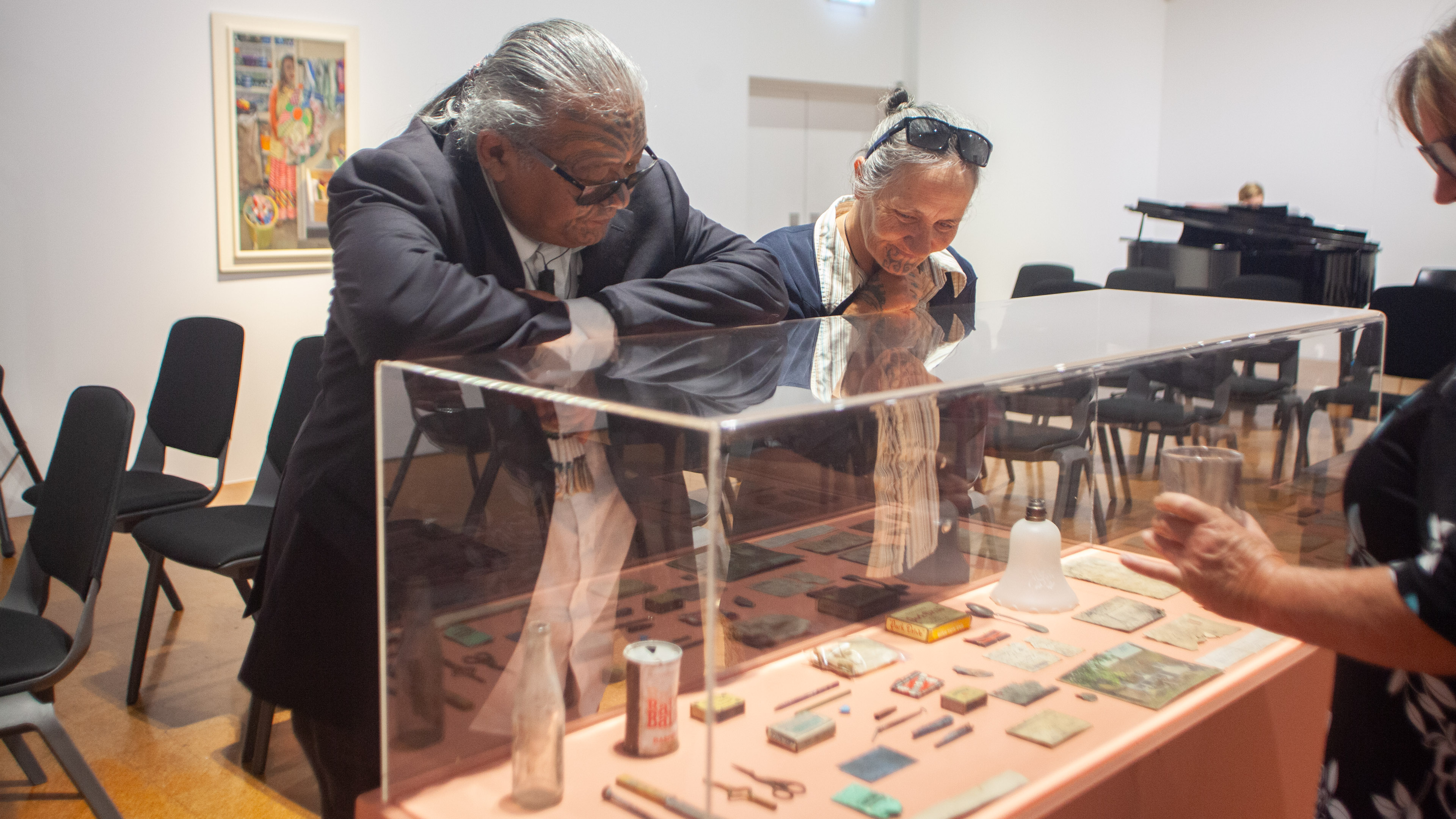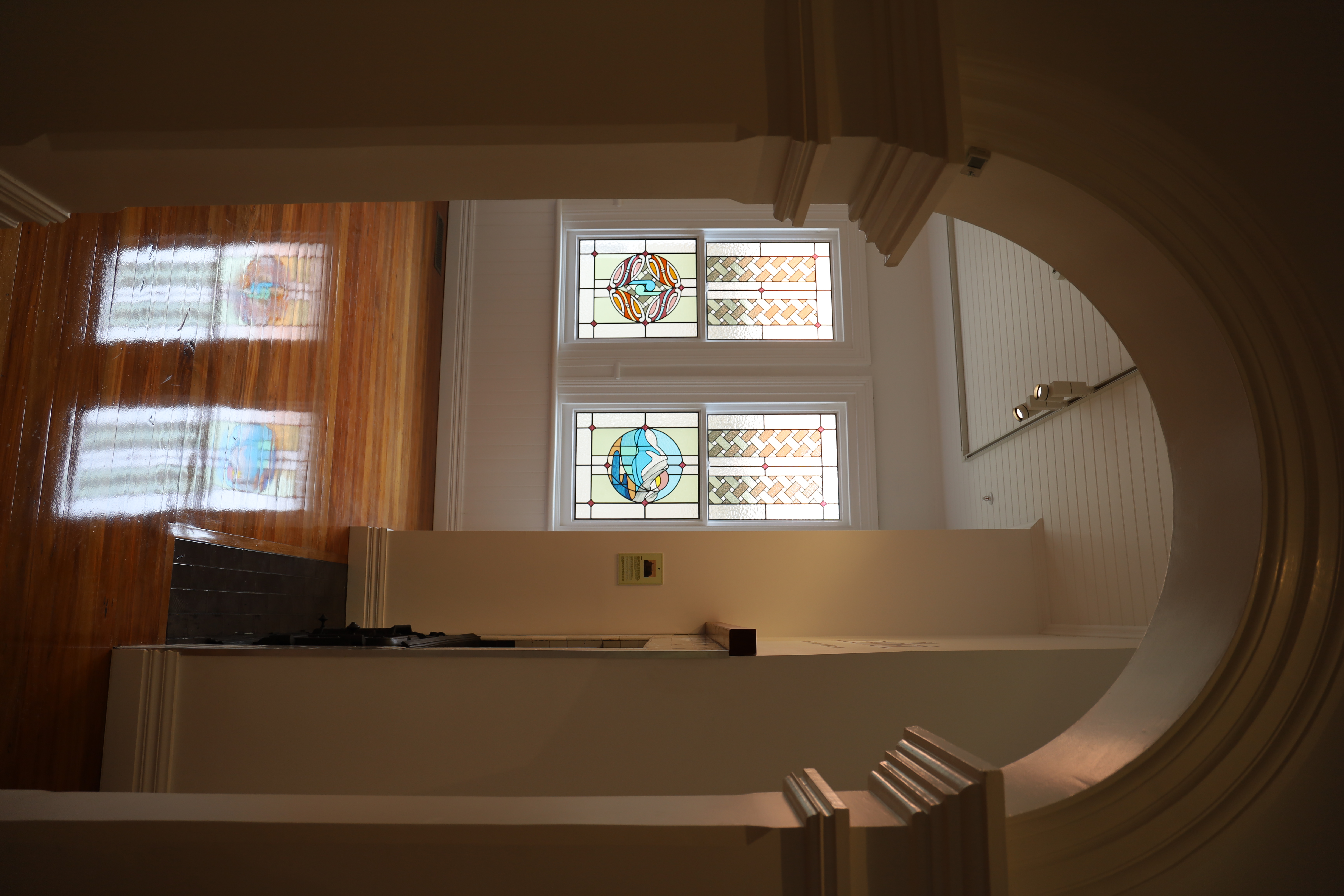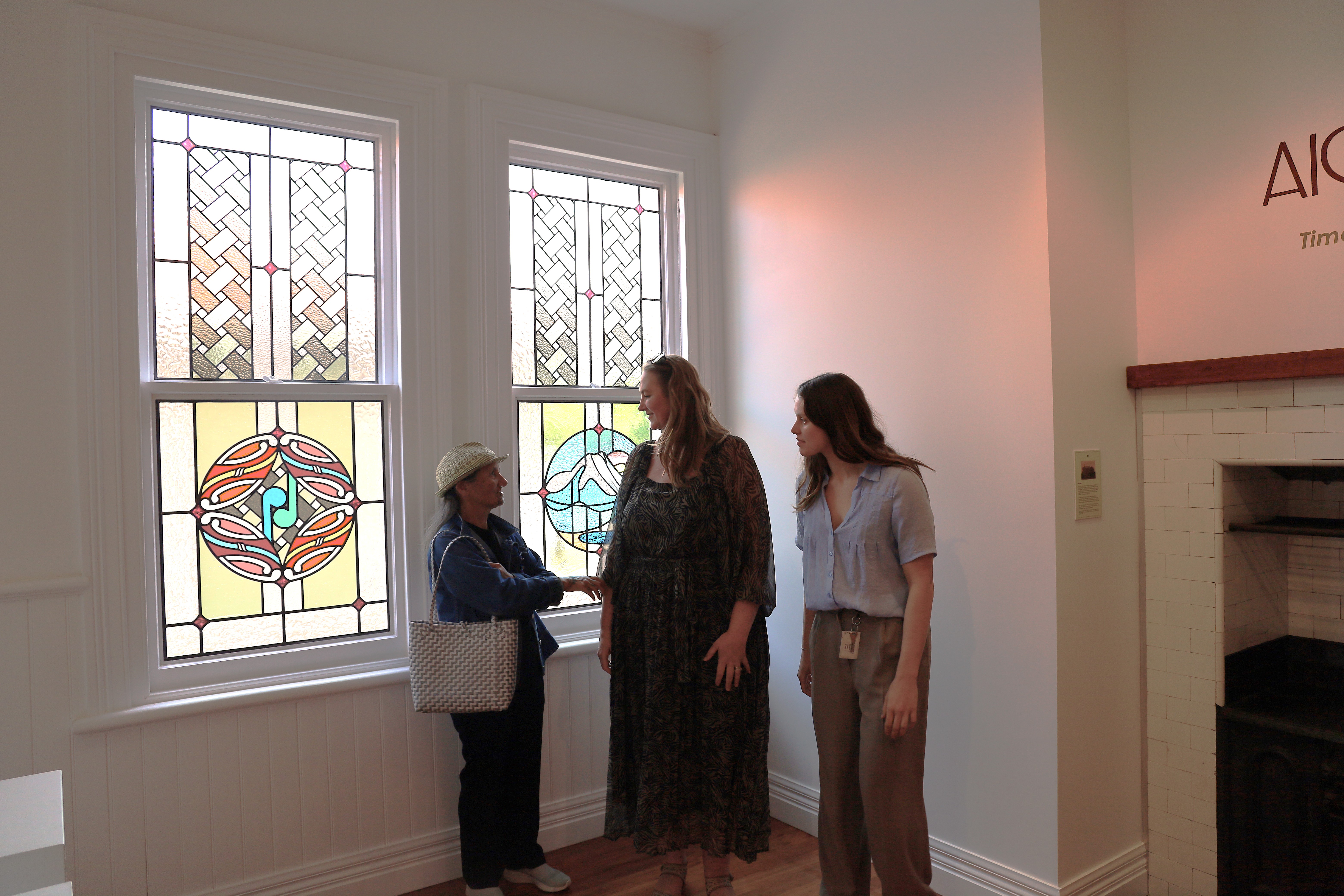Treasures of the Aigantighe:
2025
11th January
Objects Uncovered: A Window into the History of the Aigantighe House
During the earthquake strengthening and restoration project at the Aigantighe Art Gallery, a series of fascinating objects have been uncovered, offering a glimpse into the gallery's past. These finds, hidden within the building’s walls and forgotten spaces, reveal connections to the people and events that shaped the gallery’s early history.
Among the most intriguing discoveries are several personal documents. An application for a Timaru Borough Council library card provides a window into the community’s past, possibly from a time when both the library and gallery were key cultural institutions. Also found was a church card for the funeral of Alexander Grant, a pivotal figure in the gallery’s history, offering a poignant reminder of his legacy.
Further insight into the gallery’s early years comes from a series of letters and a check addressed to Clifford Brunsden, the gallery's first director. These artifacts illuminate the practical and financial aspects of running the institution in its formative years.
Perhaps the most unusual find is a nine-inch nail from the roof, likely left over from past repairs or structural changes. This item serves as a silent reminder of the building's long history of maintenance.
Another unexpected discovery was a Ballin drink can, found beneath the veranda, which hints at moments of respite for visitors of the gallery in years gone by. And in Mr. Alexander Grant’s office, behind the mantle near the French doors, semi-burnt tobacco pouches were uncovered, offering a personal glimpse into Grant’s life and times.
These objects are now on display in the main gallery as part of the exhibition Domestic Reveries, which runs until April 27th, 2025. Together, they provide a valuable glimpse into the gallery’s rich history, breathing new life into the past and enriching the ongoing narrative of this iconic institution.


4th January
Exploration of Everyday Life
Jacqueline Fahey (b. 1929) is a New Zealand painter renowned for her keen observations of domestic life and her portrayal of everyday experiences with emotional depth. Portrait of the Poet (1978) is a striking example of her ability to blend portraiture with narrative, offering an intimate insight into the subject. This work reflects Fahey’s distinctive realism, imbued with sensitivity toward the human condition.
The painting focuses on a poet, framed within their domestic environment. The subject’s contemplative and passive pose invites viewers to reflect on the relationship between the artist, the subject, and their surroundings. Fahey’s use of colour and brushwork adds richness to the psychological depth of the portrait, enhancing the viewer’s understanding of the poet’s internal world. The passive male figure, posed in a relaxed and detached manner, reorients the gaze of the viewer. The subject’s downturned eyes subtly shift the dynamics of portraiture, where subjects typically engage directly with the viewer. Instead, the poet seems lost in thought, creating a more introspective emotional exchange.
Portrait of the Poet also integrates domestic imagery with broader implications. Fahey often portrayed domestic spaces as settings for personal reflection and social context, with this work’s setting serving as both literal and metaphorical ground for contemplation and creation. The composition blends the personal and universal, with Fahey’s sensitivity to light and shadow enhancing the nuanced relationship between the individual and the intimate space they inhabit.
Displayed as part of the Aigantighe House Heritage House opening exhibition, Domestic Reveries, Portrait of the Poet continues to resonate with contemporary audiences, underscoring Fahey’s legacy in exploring domesticity and human emotion. This exhibition, running until 27 April 2025, celebrates Fahey’s contribution to New Zealand's visual arts and invites viewers to engage with her exploration of interior life, both literal and figurative.
Fahey’s work remains a powerful commentary on the quiet poetry of everyday life, and Portrait of the Poet stands as a testament to her ability to capture the profound in the mundane. Through its exploration of the passive male figure and intimate domestic space, the painting offers a meditation on the internal world and the relationship between subject, viewer, and environment.

2024
28th December
A Lens of Aoraki
Roselyn Cloake’s A Lens of Aoraki for Our Home of Art (2024) is a poignant artwork commissioned for the grand reopening of the Aigantighe Art Gallery. It serves as both a personal tribute and a powerful symbol, reflecting Roselyn’s deep connection with the region and the gallery’s history.
The piece draws inspiration from the resilience of Aoraki/Mount Cook, symbolizing endurance against harsh natural forces. Similarly, Aigantighe has long been a place of personal and artistic significance for Roselyn, where she has volunteered, exhibited, and helped preserve the gallery after the Christchurch earthquake. The gallery’s reopening, despite its challenges, mirrors the unyielding presence of Aoraki, standing strong even in cloud.
A cherished memory from a family trip to the Hooker Valley, where Roselyn and her children interacted with glacial ice, deeply influenced the artwork. They examined the ice through its lens, reflecting on the forces that shaped it. This memory of clarity and beauty amidst clouds became a key inspiration for the stained-glass window, which metaphorically captures both the natural world and the cultural significance of Aoraki.
The work, crafted in leadlight stained glass by Trinity Glass in Christchurch, offers a tactile expression of strength and beauty. It aligns with Roselyn’s cubist-inspired approach, viewing the world through multiple facets. Her piece is a tribute to the community and cultural connections at Aigantighe.
Currently on semi-permanent display in the Kitchen of the Aigantighe Heritage House, A Lens of Aoraki is part of the exhibition Domestic Reveries, which runs until 27 April 2025. The artwork honours the rose of the Aigantighe in the community, and the legacy of the Grant Family’s gift.
21st December
Te Whenua
"Te Whenua," a contemporary leadlight stained-glass window, marks the reopening of the Aigantighe Heritage House. Created by Arowhenua artist Francine Spencer and commissioned by Aigantighe Exhibitions Curator Izzy Hillman, the work is a powerful expression of Spencer’s cultural heritage and commitment to mana whenua—the rights and responsibilities of tangata whenua (the indigenous people) to care for the land.
Spencer, who whakapapas (traces her ancestry) to Taranaki, Waitaha, Kāti Mamoe, Rapuwai, and Ngāi Tahu, integrates themes of Māori sovereignty, Tino rangatiratanga, into her design. The window’s lower panel features four koru, symbolising four key groups invested in the Aigantighe's future: the Grant Family and their descendants, the Friends of Aigantighe and South Canterbury Arts Society, Timaru District Council, and the wider community of visitors and art lovers.
Additionally, Spencer incorporates three kete, or baskets, referencing the three kete of knowledge in Māori tradition. These baskets were gathered by Tāne Mahuta and represent different types of wisdom: Te Kete Tuauri (ancestral knowledge), Te Kete Aronui (knowledge of the natural world and the arts), and Te Kete Tuatea (knowledge of good and evil).
The design blends cultural heritage with contemporary resonance, intertwining respect for mana whenua with a broader Māori worldview and guardianship (tikanga). The vibrant colours and flowing forms of the stained glass reflect the diverse whakapapa (ancestral lines) and stories defining both the Aigantighe Heritage House and its community. By positioning this window in the Heritage House, Spencer creates a meaningful intersection where history and modernity converge, fostering manaakitanga—a spirit of hospitality and care.
"Te Whenua" is more than an artwork; it reflects the sacred responsibility of guardianship shared by Aigantighe’s kaitiaki (guardians). Through her work, Spencer honours her whakapapa and enriches the collective memory, encouraging a deeper understanding of the land’s journey and our connections to it.
Te Whenua is on semi-permanent display at the Aigantighe Art Gallery as part of the Domestic Reveries exhibition, running until April 27th, 2025.
14th December
Jacqueline Fahey, Christine in the Pantry, 1972-1973. Aigantighe Acc. No. 1978.5
At 94, Jacqueline Fahey ONZM is one of New Zealand's longest-active artists, with a career spanning more than five decades. Throughout this time, she has consistently used her art to comment on political issues. Some of her most well-known paintings are celebrated for capturing the frustrations and hopes that fuelled the Women's Movement.
Christine in the Pantry is currently on display at the Aigantighe Art Gallery as part of the exhibition Domestic Reveries. The exhibition spans both the newly reopened Aigantighe Heritage House and the main gallery space in the 1978 wing. It features eight paintings by Jacqueline Fahey, including two from the Aigantighe permanent collection and six on loan from Gow Langsford Gallery in Auckland.
Christine in the Pantry is a strong example of Fahey’s work. The painting depicts a woman dressed in a long, bohemian-style dress and a necklace of rainbow beads, partially obscured behind a wall and a large, colourful patchwork tea cosy hanging from a hook in the doorframe. Near her feet, a bucket filled with what appear to be socks or soft toys sits on the ground, and a kitchen drawer is left open. Through these subtle details, Fahey captures the topography of the domestic environment, showing how the acts of homemaking and intimacy can quickly turn to clutter. Despite the vibrant colours and patterns, the space feels cramped and overwhelming, and we sympathize with the subject, Christine, as she seeks refuge in the pantry. Known for her portrayal of ‘active’ figures, Fahey has Christine staring directly at the viewer, subverting the traditional male gaze with a feminine one.
The work was painted around a decade after the publication of Betty Friedan’s The Feminine Mystique, a book widely credited as an influence on Second Wave Feminism. Liberation from the confines of the domestic sphere was a hallmark of this era; Friedan’s book put words to a sense of discontent shared, but unnamed, by many women, who felt that the world offered them few opportunities outside their roles as wives and mothers.
Christine in the Pantry speaks to the rapid and radical changes that took place in the time between its creation and the beginnings of the Women’s Movement. We see a woman confronted by her choices as a modern woman: she has all the markers of a liberated flower child, but she still balances her domestic responsibilities. Fahey’s refusal to reconcile these into an image of feminist bliss is what makes her an enduring voice of the movement.
Domestic Reveries is on display at the Aigantighe Art Gallery until 27th April 2025.


